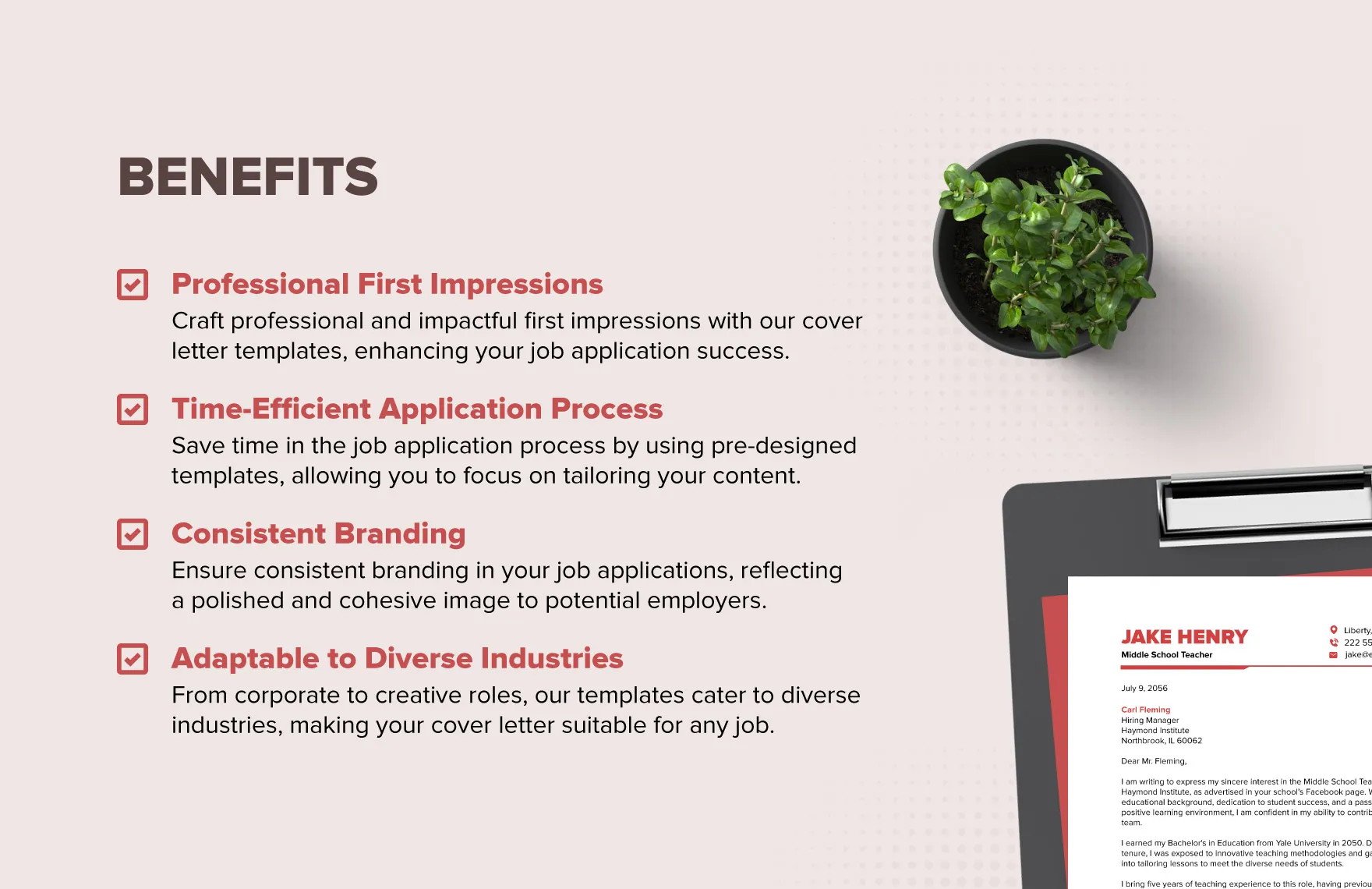Teacher Cover Letter How To Guide
Landing your dream teaching job starts with a compelling cover letter. It’s your first introduction to a potential employer, a chance to showcase your passion for education, and highlight your qualifications. A well-crafted cover letter can significantly increase your chances of getting an interview. This comprehensive guide will provide you with the essential knowledge and tools to create a teacher cover letter that stands out from the competition, ensuring your application gets noticed and read by hiring managers. Learn the key components, essential tips, and examples to help you succeed.
Understanding the Teacher Cover Letter
What is a Teacher Cover Letter?

A teacher cover letter is a document you submit along with your resume when applying for a teaching position. It serves as a personalized introduction, allowing you to elaborate on your skills, experience, and teaching philosophy. Unlike a resume, which provides a concise overview of your qualifications, a cover letter provides you with an opportunity to express your personality and demonstrate your enthusiasm for the specific role and school. It allows you to explain why you are the ideal candidate and how your skills align with the school’s needs.
Why is a Cover Letter Important?
A well-written cover letter is crucial for several reasons. First, it provides context to your resume, allowing you to highlight specific achievements and tailor your application to the job description. Second, it demonstrates your writing skills, an essential quality for teachers. Third, it allows you to express your passion for teaching and your understanding of the school’s values and goals. Moreover, a cover letter shows that you are detail-oriented and have taken the time to carefully consider the role and the institution, which shows that you are really interested. In a competitive job market, a strong cover letter can make all the difference.
Key Components of a Teacher Cover Letter
Header and Contact Information
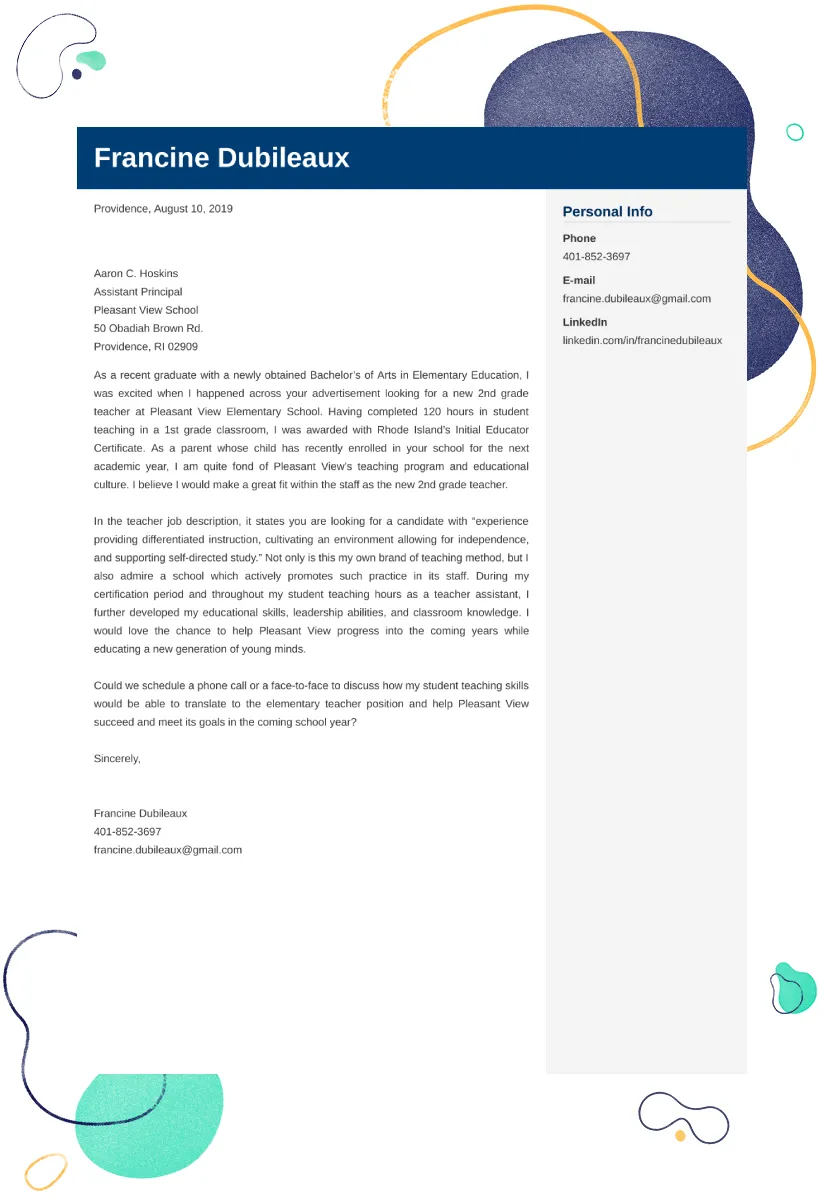
Start your cover letter with a professional header. Include your full name, address, phone number, and email address. Consider using a professional font like Times New Roman or Arial, and ensure your contact information is easily visible. This section ensures that the hiring manager can easily contact you. If applying online, make sure the email address is professional. It should look neat, clean, and simple. Ensure your contact information is current and accurate. (Image: teacher-cover-letter-header.webp)
The Salutation
The salutation sets the tone for your letter. If possible, address the hiring manager by name. This shows that you’ve done your research and are personalizing your application. If you can’t find a name, use a general greeting like ‘Dear Hiring Committee’ or ‘Dear Principal [Last Name]’. Avoid generic greetings such as ‘To Whom It May Concern,’ as they can make your letter feel impersonal. Always double-check the spelling of the name to make a great first impression.
The Introductory Paragraph
The introductory paragraph is your first opportunity to grab the reader’s attention. State the position you’re applying for and where you saw the job posting. Briefly mention your most relevant qualifications and express your enthusiasm for the role and the school. This is where you create a positive first impression, making the reader want to continue reading. Keep it concise and engaging, setting the stage for the rest of your letter. Ensure you mention your experience, and why you are interested in the particular role. (Image: teacher-writing-cover-letter.webp)
Highlighting Your Qualifications
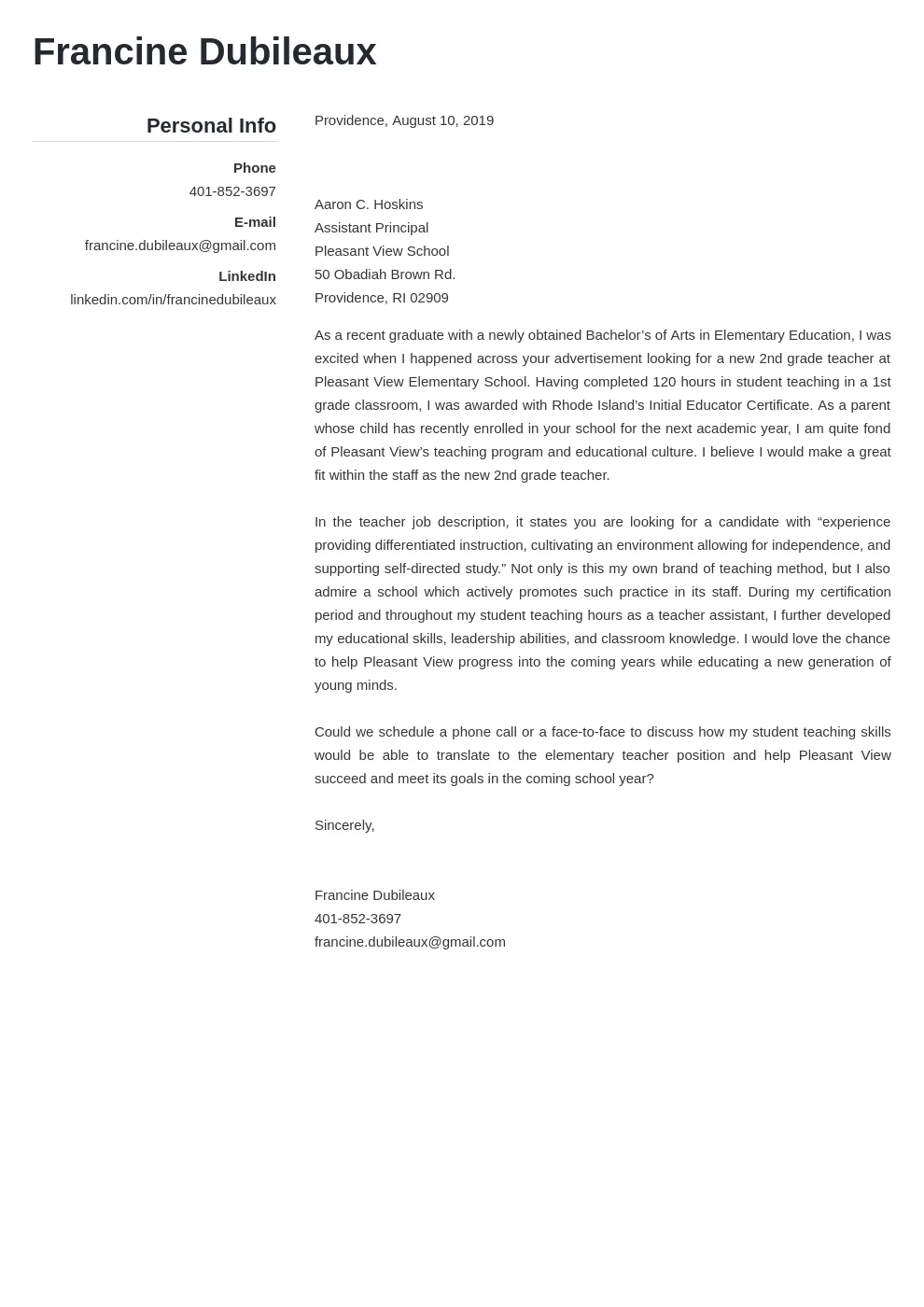
In the body of your cover letter, elaborate on your qualifications. Focus on the skills and experiences that align with the job description. Mention your relevant degrees, certifications, and any specializations. Use specific examples to demonstrate your abilities. Mention your teaching style, philosophy, and any techniques that have proven successful. You can also talk about your experience with different student populations or any special training that you have. Make sure to use keywords from the job description and connect them to your skills and experience.
Showcasing Your Experience
Use your cover letter to showcase your teaching experience. Describe your previous roles, the grades you taught, and the subjects you specialized in. Mention any significant accomplishments, such as improvements in student test scores, successful curriculum development, or positive feedback from parents and administrators. If you are a new teacher, focus on your student teaching experiences, volunteer work, or any relevant extracurricular activities. Quantify your achievements whenever possible, for example, ‘Increased student test scores by 15%’.
Emphasizing Skills and Achievements
Highlight your key skills and achievements to make you a great fit for the role. Include skills like classroom management, curriculum development, lesson planning, communication, and collaboration. Back up these skills with specific examples. For example, ‘Implemented a new classroom management system that reduced disciplinary issues by 30%.’ If you have received any awards or recognition, include those as well. This is where you really sell yourself, so highlight your successes and demonstrate your value as a teacher. (Image: teacher-cover-letter-components.webp)
The Closing Paragraph
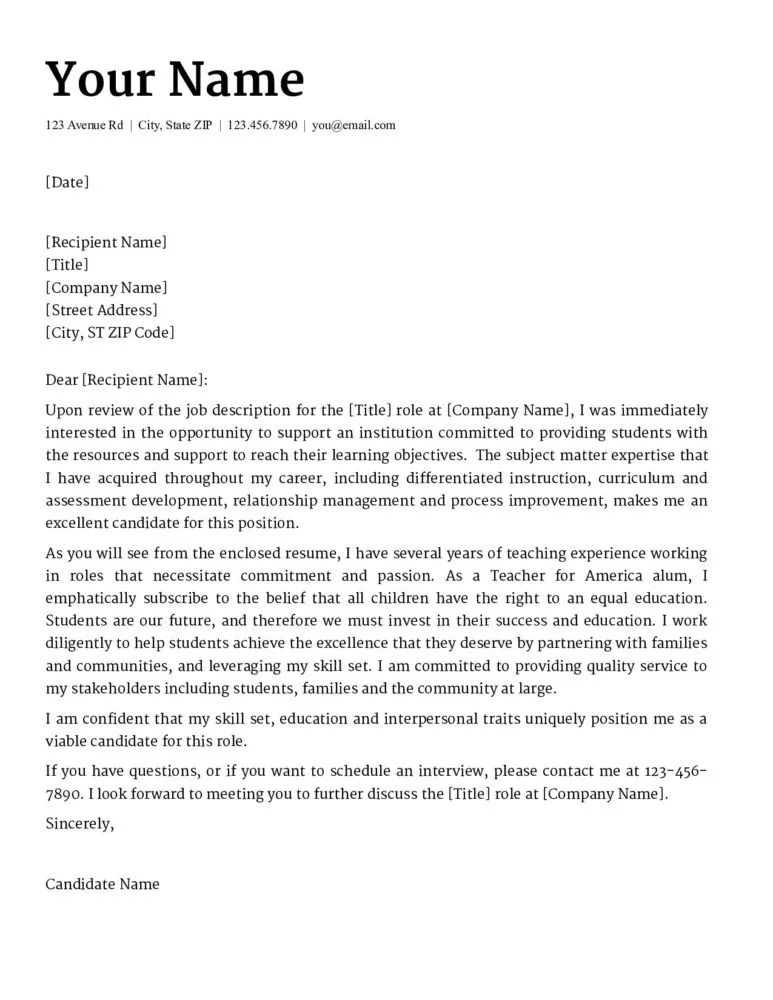
In your closing paragraph, express your interest in an interview. Thank the hiring manager for their time and consideration. Reiterate your enthusiasm for the position and mention your availability for an interview. Provide your contact information one more time. Keep it concise and professional. A strong closing paragraph leaves the reader with a positive impression and increases your chances of being contacted.
Formatting and Style
Your cover letter’s formatting and style are just as important as its content. Use a professional font, such as Times New Roman, Arial, or Calibri, in a 10–12 point size. Keep your letter to one page, if possible. Use clear, concise language and avoid jargon. Use paragraphs to break up the text and make it easier to read. Proofread your letter carefully to eliminate any typos or grammatical errors. Maintain a professional tone throughout the letter.
Proofreading and Editing
Before submitting your cover letter, proofread it meticulously. Check for spelling, grammar, and punctuation errors. Have someone else review your letter to catch any mistakes you might have missed. Typos and errors can make a negative impression, so take the time to ensure your letter is polished and professional. Consider using grammar-checking software, but always review the results yourself.
Essential Tips for Writing a Teacher Cover Letter
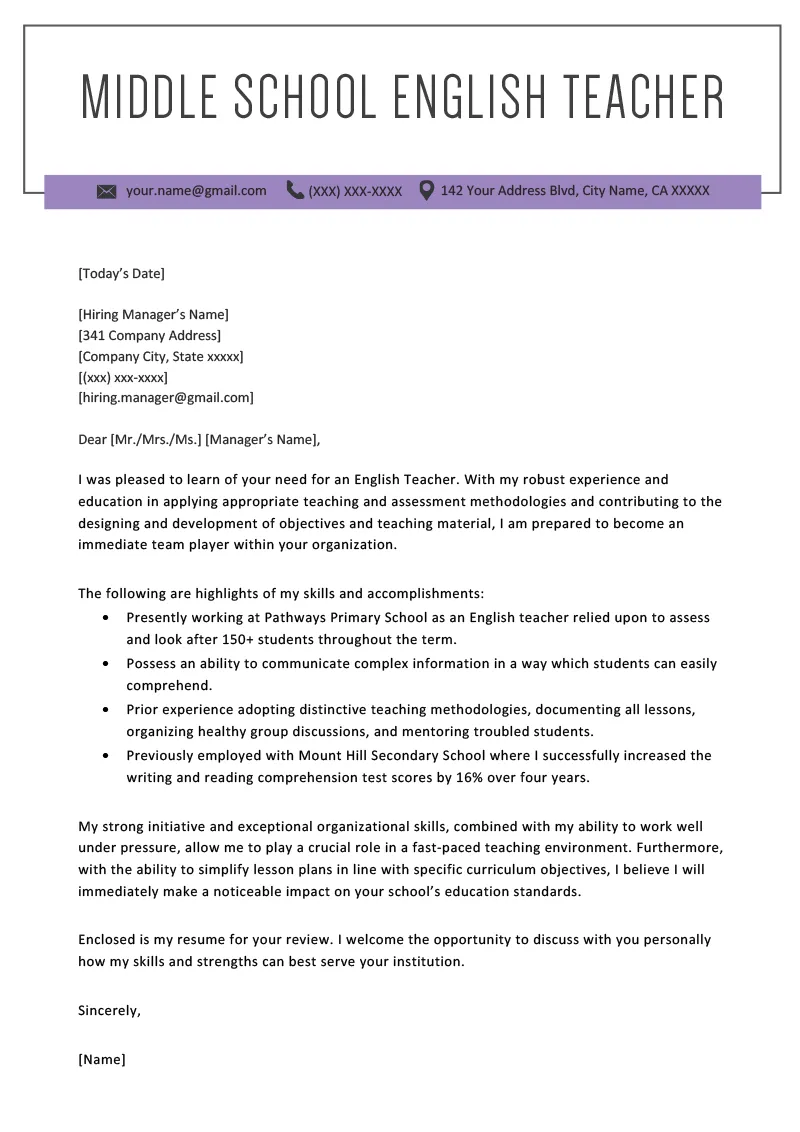
Tailoring Your Letter
Always tailor your cover letter to each specific job. Do not use a generic template. Research the school and the position, and address the specific requirements and needs outlined in the job description. Highlight how your skills and experience align with the school’s values and goals. Customize your letter to show that you are genuinely interested in the specific opportunity, not just any teaching job. Mention specific programs or initiatives that excite you. (Image: teacher-tailoring-cover-letter.webp)
Using Action Verbs
Use strong action verbs to describe your skills and accomplishments. Action verbs make your letter more dynamic and engaging. Start each bullet point or sentence with a powerful action verb, such as ‘Developed,’ ‘Implemented,’ ‘Managed,’ ‘Created,’ ‘Led,’ ‘Collaborated,’ and ‘Assessed.’ Action verbs make your accomplishments and skills stand out. This helps to give your accomplishments more power and impact. Avoid passive voice whenever possible. (Image: teacher-action-verbs.webp)
Show, Don’t Tell
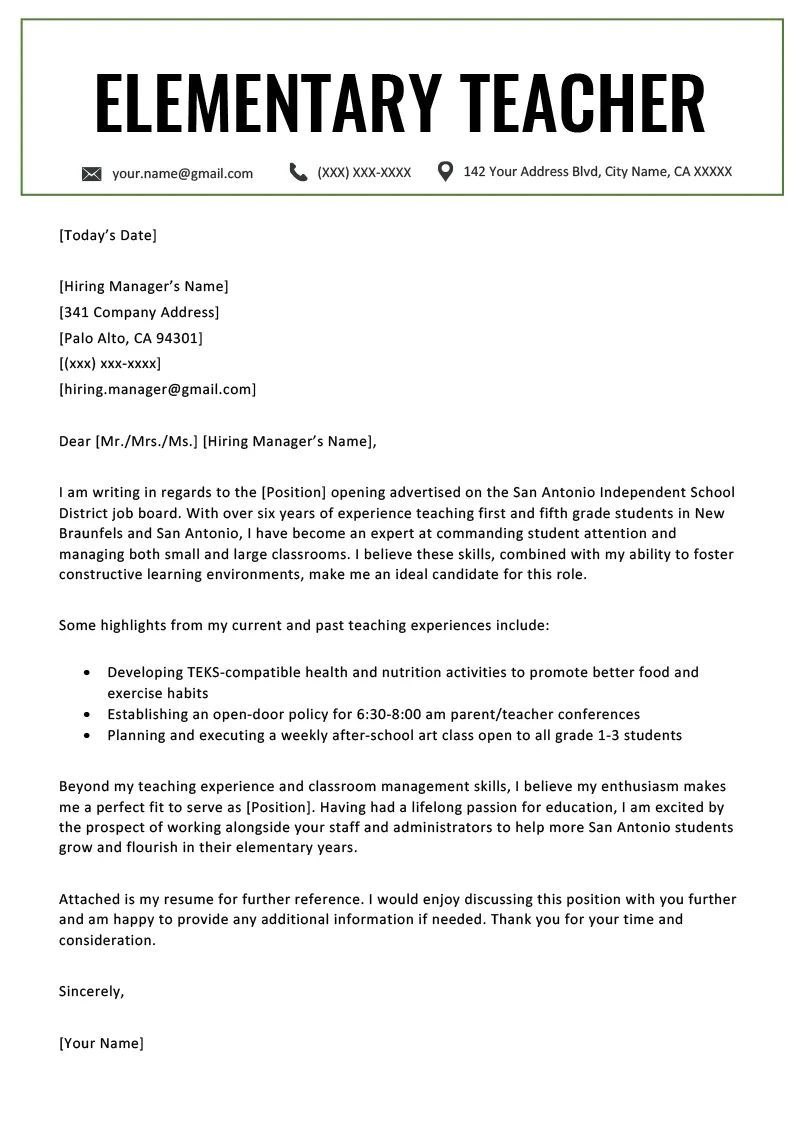
Instead of simply stating that you are a good teacher, provide specific examples to illustrate your skills. Show the hiring manager what you have accomplished and the impact you’ve made. For example, instead of saying ‘I am a good classroom manager,’ say, ‘Implemented a new classroom management system, resulting in a 25% reduction in disruptive behavior.’ Providing examples makes your claims more credible and memorable. This shows the value of what you do.
Addressing the Principal
Whenever possible, address the cover letter to the principal or hiring manager by name. Research the school’s website or call the school to find out who is responsible for hiring. Addressing the letter to a specific person shows that you have taken the time to learn about the school and its staff. If you can’t find a name, use a title, such as ‘Dear Hiring Committee’ or ‘Dear Principal’. Make sure to get the name right and spell it correctly.
Highlighting Specific Skills
Review the job description and identify the key skills and qualifications the school is seeking. Tailor your cover letter to address these specific requirements. Provide examples of how you have demonstrated these skills in the past. For example, if the job description emphasizes technology integration, highlight your experience using educational software or interactive whiteboards. This will show the school that you are ready to hit the ground running and make an impact on day one.
Cover Letter Examples
Example for Elementary School Teacher
Dear [Principal’s Name],
I am writing to express my enthusiastic interest in the Elementary School Teacher position at [School Name], as advertised on [Platform]. With a Bachelor’s degree in Elementary Education and three years of experience teaching first grade at [Previous School], I am confident in my ability to create a nurturing and engaging learning environment.
In my previous role, I developed and implemented a comprehensive reading program that improved student literacy rates by 20%. I am proficient in differentiated instruction, creating lesson plans that cater to diverse learning styles. I also have a strong background in classroom management and fostering positive relationships with students and parents. I am excited about the opportunity to contribute to the [School Name] community and am eager to learn more about this position.
Thank you for your time and consideration. I look forward to the possibility of discussing my qualifications further.
Sincerely, [Your Name]
Example for High School Teacher
Dear [Principal’s Name],
I am writing to apply for the High School Teacher position in [Subject Area] at [School Name], as posted on [Platform]. I am a highly motivated educator with a Master’s degree in [Subject Area] and five years of experience teaching [Subject] at [Previous School].
During my time at [Previous School], I developed a new curriculum that increased student engagement and improved test scores. I have experience with a variety of teaching methodologies, including project-based learning and collaborative projects, and I am also adept at using technology to enhance learning. I am passionate about [Subject] and dedicated to helping students succeed.
Thank you for considering my application. I welcome the chance to speak with you and learn more about the role.
Sincerely, [Your Name]
Example for Special Education Teacher
Dear [Principal’s Name],
I am writing to express my interest in the Special Education Teacher position at [School Name], as advertised on [Platform]. I hold a Master’s degree in Special Education and have six years of experience working with students with diverse learning needs.
In my previous role at [Previous School], I developed individualized education programs (IEPs) that resulted in significant progress for students with disabilities. I am skilled in creating inclusive classrooms, implementing behavior management techniques, and collaborating with parents and support staff. I am deeply committed to providing a supportive and engaging learning environment for all students.
Thank you for your time and consideration. I hope to hear from you soon.
Sincerely, [Your Name]
Common Mistakes to Avoid
Generic Letters
Avoid using a generic cover letter that you send to every school. Hiring managers can easily spot generic letters, and they will likely be discarded. Tailor your letter to each specific job and school, demonstrating your genuine interest in that particular opportunity. Show that you have researched the school, understand their needs, and explain why you are a perfect fit. A customized cover letter shows your commitment to the school and the position.
Typos and Grammatical Errors
Typos and grammatical errors can make a negative impression. Before submitting your cover letter, proofread it carefully. Check for spelling, grammar, punctuation, and formatting errors. Consider having someone else review your letter as well. Errors show a lack of attention to detail, which is critical for teachers. Use grammar-checking software, but don’t rely on it entirely.
Lack of Enthusiasm
Your cover letter should convey your enthusiasm for teaching and your excitement about the specific opportunity. Show passion for the subject matter, your teaching philosophy, and the school’s mission. Avoid a tone that is bland or uninspired. Use strong, positive language to express your eagerness to contribute to the school’s community and make a difference in students’ lives. Your passion will resonate with the hiring manager. (Image: teacher-cover-letter-mistakes.webp)
Ignoring the Job Description
The job description provides crucial information about the skills, experience, and qualifications the school is seeking. Tailor your cover letter to address the specific requirements listed in the job description. Highlight the relevant skills and experiences, and provide examples to demonstrate how you meet the requirements. If the job description mentions specific technologies, teaching methodologies, or experience with specific student populations, be sure to address these areas in your letter.
Conclusion The Next Steps
A well-crafted cover letter is a vital component of your job application. By following these guidelines, including key components, essential tips, and avoiding common mistakes, you can create a cover letter that showcases your skills and experience, expresses your passion for teaching, and significantly increases your chances of landing an interview. Remember to always tailor your letter to each specific job, and always proofread carefully. Good luck with your job search. (Image: teacher-cover-letter-example.webp)
